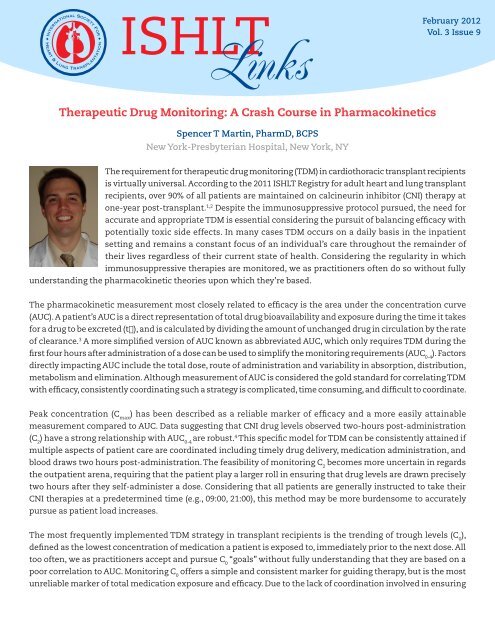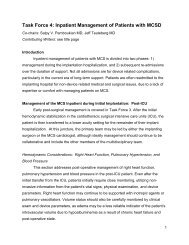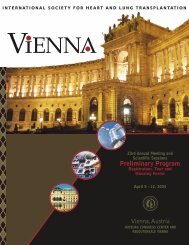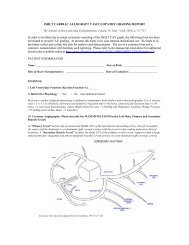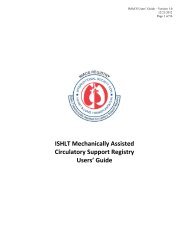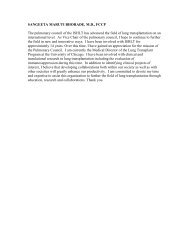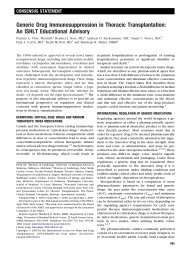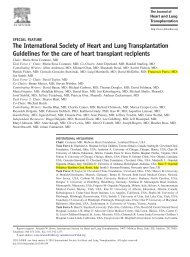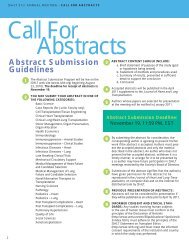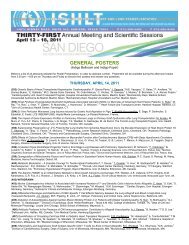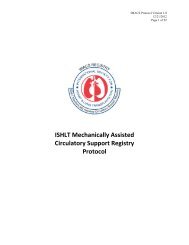Therapeutic Drug Monitoring: A Crash Course in Pharmacokinetics
Therapeutic Drug Monitoring: A Crash Course in Pharmacokinetics
Therapeutic Drug Monitoring: A Crash Course in Pharmacokinetics
You also want an ePaper? Increase the reach of your titles
YUMPU automatically turns print PDFs into web optimized ePapers that Google loves.
February 2012<br />
Vol. 3 Issue 9<br />
<strong>Therapeutic</strong> <strong>Drug</strong> <strong>Monitor<strong>in</strong>g</strong>: A <strong>Crash</strong> <strong>Course</strong> <strong>in</strong> Pharmacok<strong>in</strong>etics<br />
Spencer T Mart<strong>in</strong>, PharmD, BCPS<br />
New York-Presbyterian Hospital, New York, NY<br />
The requirement for therapeutic drug monitor<strong>in</strong>g (TDM) <strong>in</strong> cardiothoracic transplant recipients<br />
is virtually universal. Accord<strong>in</strong>g to the 2011 ISHLT Registry for adult heart and lung transplant<br />
recipients, over 90% of all patients are ma<strong>in</strong>ta<strong>in</strong>ed on calc<strong>in</strong>eur<strong>in</strong> <strong>in</strong>hibitor (CNI) therapy at<br />
one-year post-transplant. 1,2 Despite the immunosuppressive protocol pursued, the need for<br />
accurate and appropriate TDM is essential consider<strong>in</strong>g the pursuit of balanc<strong>in</strong>g efficacy with<br />
potentially toxic side effects. In many cases TDM occurs on a daily basis <strong>in</strong> the <strong>in</strong>patient<br />
sett<strong>in</strong>g and rema<strong>in</strong>s a constant focus of an <strong>in</strong>dividual’s care throughout the rema<strong>in</strong>der of<br />
their lives regardless of their current state of health. Consider<strong>in</strong>g the regularity <strong>in</strong> which<br />
immunosuppressive therapies are monitored, we as practitioners often do so without fully<br />
understand<strong>in</strong>g the pharmacok<strong>in</strong>etic theories upon which they’re based.<br />
The pharmacok<strong>in</strong>etic measurement most closely related to efficacy is the area under the concentration curve<br />
(AUC). A patient’s AUC is a direct representation of total drug bioavailability and exposure dur<strong>in</strong>g the time it takes<br />
for a drug to be excreted (t¥), and is calculated by divid<strong>in</strong>g the amount of unchanged drug <strong>in</strong> circulation by the rate<br />
of clearance. 3 A more simplified version of AUC known as abbreviated AUC, which only requires TDM dur<strong>in</strong>g the<br />
first four hours after adm<strong>in</strong>istration of a dose can be used to simplify the monitor<strong>in</strong>g requirements (AUC 0-4<br />
). Factors<br />
directly impact<strong>in</strong>g AUC <strong>in</strong>clude the total dose, route of adm<strong>in</strong>istration and variability <strong>in</strong> absorption, distribution,<br />
metabolism and elim<strong>in</strong>ation. Although measurement of AUC is considered the gold standard for correlat<strong>in</strong>g TDM<br />
with efficacy, consistently coord<strong>in</strong>at<strong>in</strong>g such a strategy is complicated, time consum<strong>in</strong>g, and difficult to coord<strong>in</strong>ate.<br />
Peak concentration (C max<br />
) has been described as a reliable marker of efficacy and a more easily atta<strong>in</strong>able<br />
measurement compared to AUC. Data suggest<strong>in</strong>g that CNI drug levels observed two-hours post-adm<strong>in</strong>istration<br />
(C 2<br />
) have a strong relationship with AUC 0-4<br />
are robust. 4 This specific model for TDM can be consistently atta<strong>in</strong>ed if<br />
multiple aspects of patient care are coord<strong>in</strong>ated <strong>in</strong>clud<strong>in</strong>g timely drug delivery, medication adm<strong>in</strong>istration, and<br />
blood draws two hours post-adm<strong>in</strong>istration. The feasibility of monitor<strong>in</strong>g C 2<br />
becomes more uncerta<strong>in</strong> <strong>in</strong> regards<br />
the outpatient arena, requir<strong>in</strong>g that the patient play a larger roll <strong>in</strong> ensur<strong>in</strong>g that drug levels are drawn precisely<br />
two hours after they self-adm<strong>in</strong>ister a dose. Consider<strong>in</strong>g that all patients are generally <strong>in</strong>structed to take their<br />
CNI therapies at a predeterm<strong>in</strong>ed time (e.g., 09:00, 21:00), this method may be more burdensome to accurately<br />
pursue as patient load <strong>in</strong>creases.<br />
The most frequently implemented TDM strategy <strong>in</strong> transplant recipients is the trend<strong>in</strong>g of trough levels (C 0<br />
),<br />
def<strong>in</strong>ed as the lowest concentration of medication a patient is exposed to, immediately prior to the next dose. All<br />
too often, we as practitioners accept and pursue C 0<br />
“goals” without fully understand<strong>in</strong>g that they are based on a<br />
poor correlation to AUC. <strong>Monitor<strong>in</strong>g</strong> C 0<br />
offers a simple and consistent marker for guid<strong>in</strong>g therapy, but is the most<br />
unreliable marker of total medication exposure and efficacy. Due to the lack of coord<strong>in</strong>ation <strong>in</strong>volved <strong>in</strong> ensur<strong>in</strong>g
February 2012<br />
Vol. 3 Issue 9<br />
an accurate level, this method is often utilized.<br />
Regardless of the TDM plan chosen for the patient, major limitations exist <strong>in</strong> ensur<strong>in</strong>g accuracy, and are often<br />
overlooked. Practitioners are forced to assume that patients are tak<strong>in</strong>g medications at the prescribed dose at the<br />
prescribed times, and that the levels are drawn exactly 12 hours after the previous dose if monitor<strong>in</strong>g C 0<br />
. <strong>Drug</strong><br />
levels can be <strong>in</strong>fluenced by multiple factors <strong>in</strong>clud<strong>in</strong>g deviation <strong>in</strong> diet or eat<strong>in</strong>g habits, tak<strong>in</strong>g additional over-thecounter<br />
or prescription medications without practitioner awareness, self-prescrib<strong>in</strong>g with herbal remedies and<br />
teas, or convert<strong>in</strong>g between brand name to generic formulations without prescriber knowledge. <strong>Monitor<strong>in</strong>g</strong> levels<br />
without recognition of external <strong>in</strong>fluences may result <strong>in</strong> unnecessary reductions or <strong>in</strong>creases <strong>in</strong> dose, potentially<br />
produc<strong>in</strong>g an <strong>in</strong>effective or toxic drug regimen.<br />
A sound understand<strong>in</strong>g of the pharmacok<strong>in</strong>etics related to the most frequently used medications are required<br />
to ensure optimal monitor<strong>in</strong>g. Several strategies for TDM of CNIs have been validated, each display<strong>in</strong>g benefits<br />
and pitfalls. Despite an <strong>in</strong>dividual program’s preference for TDM strategy, constant evaluation of the accuracy<br />
and appropriateness of levels is a necessity. It is the responsibility of all members of the multidiscipl<strong>in</strong>ary team<br />
to rema<strong>in</strong> vigilant <strong>in</strong> ensur<strong>in</strong>g appropriate TDM to ma<strong>in</strong>ta<strong>in</strong> the highest level of pharmaceutical and patient care.<br />
Disclosure Statement: Dr. Mart<strong>in</strong> produces cont<strong>in</strong>u<strong>in</strong>g education for The Immunology Report, a group funded by an educational<br />
grant from Astellas Pharma US, Inc.<br />
References:<br />
1. Christie JD, Edwards LB, Kucheryavaya AY, et al. The registry of the <strong>in</strong>ternational society for heart and lung transplantation:<br />
twenty-eighth adult lung and heart-lung transplant report-2011. J Heart Lung Transplant 2011;30(10):1104-1122.<br />
2. Stehlik J, Edwards LB, Kucheryavaya AY, et al. The registry of the <strong>in</strong>ternational society for heart and lung transplantation:<br />
twenty-eighth adult heart transplant report-2011. J Heart Lung Transplant 2011;30(10):10781094.<br />
3. Shargel L, Yu ABC. Applied Biopharmaceutics & Pharmacok<strong>in</strong>etics. 4 th ed. London: Appleton & Lange; 1999.<br />
4. Holt DW. <strong>Therapeutic</strong> drug monitor<strong>in</strong>g of immunosuppressive drugs <strong>in</strong> kidney transplantation. Curr Op<strong>in</strong> Nephrol<br />
Hypertens 2002.11:657-663.


